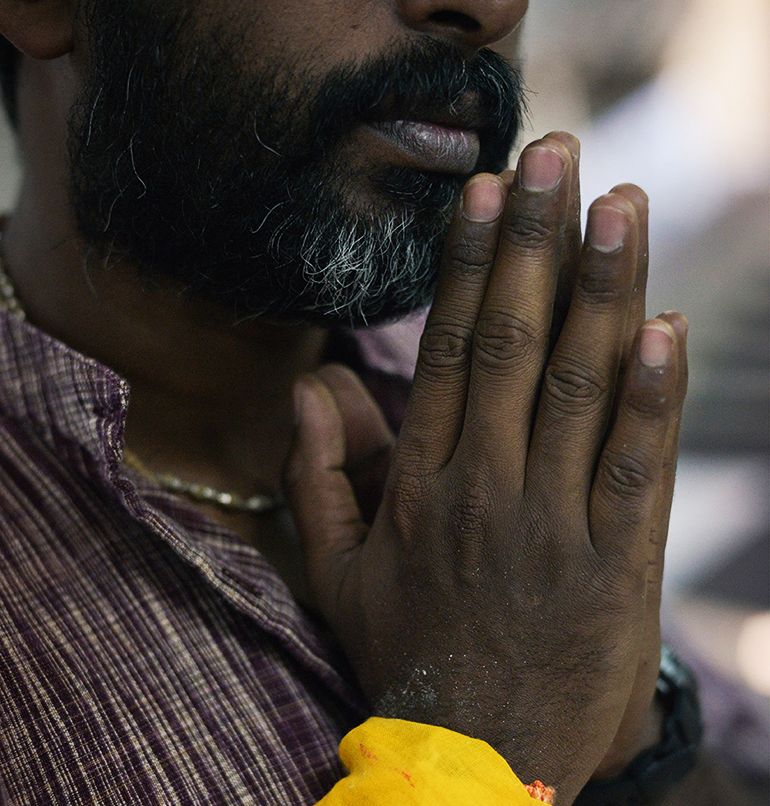“I am a sequence smoker,” says a Kavadi maker. “Every day one packet.”
I am station amidst piles of plywood and steel fittings, appetite collection on a building and sawdust in a air, underneath a front porch shutter of a elementary patio residence on a hinterland of Banting, 45 mins from Kuala Lumpur. Outside, in a prohibited afternoon sun, half finished Kavadis mount on a asphalt, some small skeletons of steel rods and plywood, unrecognisable. This is where Kavadis—a earthy weight carried by Hindus as an act of penance during a festival of Thaipusam—are made. we consult a stage before me. we had approaching it to be rather reduction industrial, some-more visionary – maybe an ascetic hand-crafting his creations, amid swirls of camphor smoke. But cigarette smoking is a review during hand. “I’m a sequence smoker, yet given a month of Thai began, not a singular stick.”

Bala operative on a Kavadi
Bala, a Kavadi maker, is referring to a Hindu month of Thai, from that a Hindu festival Thaipusam derives a name. On a day we accommodate him, he has not had a fume for 3 weeks. Along with other Hindu devotees, Bala undergoes fasting for 48 days (the generation of a month in a Hindu calendar), abstaining from party and oppulance before a day-long proceed that is a face of Thaipusam. Bala proudly shows me an manuscript of journal clippings, where any print or discuss of his Kavadis in a press has been lovingly laminated and bound. It is a work of love. “It’s not unequivocally about a money,” he says in a thick Tamil accent, “I assistance people to do their pilgrimage.”

Putting a finishing touches on a Kavadi and contrast it out
A event with opposite paths
I accommodate one of Bala’s business during a march of my visit. K. Anuharan has come to check on a swell of his Kavadi. Wearing a thick, silver-speckled brave and a malar (sort of a Hindu rosary) around his neck, he surprises me by vocalization ideal English. His Kavadi is comparatively medium by stream standards, yet still measures over 5 feet in tallness and width, and weighs around 30 kg. Balance is a hallmark of a well-crafted Kavadi, and Anuharan is here to make certain that a Kavadi’s heft is uniformly distributed opposite his shoulders. “As distant behind as we can remember, we have been fasten a Thaipusam proceed during Batu Caves any year.” At my disbelief, he strains to remember if he has ever missed one. “No,” he finally says. “Even now that we am staying in Australia, we will fly behind any Thaipusam.”
Selva is another Hindu advocate who will lift a Kavadi this year. An operative during an airline association formed in KL and an zealous marathon runner, he too has assimilated a proceed any year given childhood. Even when he was operative in Singapore during his younger days, he assimilated a proceed in Singapore.
The Kavadi that Selva will lift is totally opposite from Anuharan’s. He shows me a print of it on his phone. It is a elementary timber pole, modestly embellished, that will be offset opposite his shoulders. At both ends of a pole, he will hang a jar of milk, that devotees move to a church as an offering. While a incomparable Kavadis and a fantastic Vel Kavadis (which are trustworthy to bearers partly by steel spikes pierced into a bearers’ skin) are a ones that squeeze a courtesy of photographers and a public, it is Selva’s understated Kavadi that is closer to a normal form. “The normal Kavadi is merely a stick with an arch over it, that rests on a bearer’s shoulder,” explains Kandasamy Velayuthan, Deputy President of a Malaysian Hindu Sangam, a physique that oversees Thaipusam celebrations in Malaysia. “It should usually be flashy with palm branches, peacock feathers and fruits that are used for prayers.” Over a years, Kavadis grew bigger and some-more elaborate. Kandasamy admits that this could be partly fuelled by one-upmanship among devotees, yet is also due to a opposite vows done by opposite devotees. Perhaps any male has his possess weight to carry.

Anuharan charity prayers before a large day
Diverging beliefs
Both Anuharan and Selva determine to me following them during a Thaipusam procession. Knowing that we have no before experience, they report to me a standard Thaipusam procession.
The proceed itself is a rough epic. Over a million devotees take a two-kilometre proceed to Batu Caves, many carrying Kavadis of all sizes, a atmosphere rattling with a raging drumbeats of normal song troupes. Though a rituals practised competence differ, a channel is mostly similar: The proceed starts on a banks of a Batu River, where devotees rinse themselves as a mystic form of cleansing, Hindu priests offer prayers, and a devotees take adult their Kavadis. At this point, all a avoidance and fasting and imagining of a prior 48 days come to a head. Many Kavadi bearers will enter into a trance. Anuharan describes a experience: “The appetite of a deity is channeled into you, and it’s as if we remove control of your body. You are wakeful of your surroundings, yet it’s as if another appetite is determining your body, giving we a continuation and concentration to finish a procession. Sometimes we even remove alertness completely, so we have no correlation of events during a trance. You enter into a coma during a stream bank, and arise adult during Batu Caves!”
The power of a coma depends really most on a devotee’s preparations forward of a large day. “Sometimes we get a good trance, infrequently we get a diseased trance,” says Anuharan. “If we didn’t ready with a right suggestion – quick scrupulously or spend time meditating – we will get a diseased trance, and this means we competence not have a strength to finish a procession. It is pronounced that a piercings would harm too,” he continues, referring to a common use of trenchant one’s self with steel skewers or hooks, as an concomitant act of penance.
Piercings have turn a indicate of contention. Some, like Anuharan, remonstrate with a practice. “Hinduism never asks me to harm myself,” he says. “It is a form of penance for some, they make a vouch to do it, and so they contingency perform that vow. But for me, we don’t do it.” Selva, though, has had piercings before, and offers his counterpoint. “I have listened that when a skewer is pierced by a tip of a tongue, it touches a haughtiness on a tongue that helps a mind to concentration and keep it in a pondering state during a procession.”

A clergyman restraining a Kappu on Anuharan’s palm and blessing him and his family
The home stretch
Three days before Thaipusam, devotees who devise to attend in a proceed revisit a church to offer special prayers. Anuharan, whose event began in Australia, offers his prayers during a Ayappan church circuitously Batu Caves. A clergyman affixes a square of turmeric on a string, sprinkles it with red Kunkum powder, and ties it to Anuharan’s hand. It is called a Kappu. It is a pointer that a dispatcher has done a vow, and is now portion out his penance. For a subsequent 3 days, Anuharan will stay during a temple, sleeping on a building during night, meditating and avoiding secular distractions.
Selva, no foreigner to tests of endurance, is attack a home widen too. His vows of avoidance will grow some-more severe, and he too will discuss more. Bala, a Kavadi maker, has most some-more to do. He has set adult a tent circuitously a Batu River, that will offer as his bottom of operations. Last-minute requests from business leave him busy. At a same time, he too needs to observe all his vows. By day he scrambles to finish Kavadis, by night he and his mother nap during circuitously temples. On Thaipusam day, Bala will perform a proceed over and over again. He or members of his group need to travel with a devotees who lease his Kavadi all a proceed to a Batu Caves temple, and collect a Kavadi in time for a subsequent rental. Anuharan, Selva, and Bala are only 3 of an estimated 1.5 million people who will mob Batu Caves this year. Each will proceed Batu Caves with opposite vows, temperament opposite burdens, carrying walked opposite paths. This is a final buildup of spirituality, for all of them.

Anuharan perplexing out a Kavadi
A common burden
Why do we do it? we ask. Though Anuharan and Selva differ in their use of Thaipusam, they both offer a same answers – invocation and tradition. “I lift a large Kavadi given we once done a request, and it was answered miraculously. In return, we vowed to lift a large Kavadi any year, so this is a accomplishment of that vow,” explains Anuharan. Selva has never done a specific vow, yet he, too, sees a Thaipusam proceed as an act of thanksgiving.
“It is a proceed of expressing my thankfulness for a blessings in my life, and during a same time, to ask for a blessings to continue.” Selva adds, “It is partial of my temperament as a Hindu. My family has always participated in a Thaipusam procession, and when a time comes we will pass this on to my children.” Anuharan concurs. “Every year, ever given we can remember, my family has taken this pilgrimage. It is a tradition value keeping.”
——–
Journey with us, as we go on a event to Batu Caves in a second partial of this series: A Walk Among Gods
Want to know some-more about Thaipusam and other festivals and events in Malaysia? Visit www.tourism.gov.my for some-more information.

Recent Comments